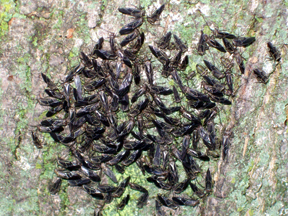Tree cattle causing undue concern
Editor’s note: This article is from the archives of the MSU Crop Advisory Team Alerts. Check the label of any pesticide referenced to ensure your use is included.
Several people sent me photos of large groups of small insects called tree cattle crawling about their maple tree trunks. Tree cattle, Cerastipsocus venosus (Psocoptera: Psocidae) are large barklice and get their common name from their habit of forming large colonies that move about in unison (much like a herd of cattle, I guess). Tree cattle are harmless and no cause for concern.
Most species of booklice and barklice are very small, almost microscopic in size. Tree cattle are huge in comparison, reaching nearly a quarter of inch long when mature. Psocids are easily identified by their swollen faces and long antennae. Tree cattle nymphs appear dark gray with pale yellow banding between abdominal segments. Adults have shiny black wings that are held tent-like over their abdomens. The term "lice" as part of the common name of these tree dwellers is quite misleading as these insects are neither parasitic nor louse-like in appearance. As scavengers, tree cattle perform a valuable function in consuming excess accumulations of fungi, algae, dead bark and other materials that occur on tree trunks and large limbs. Tree cattle do not eat leaves or the bark of the tree, nor do they damage the tree by boring into the bark and control measures are not recommended for these insects.



 Print
Print Email
Email



